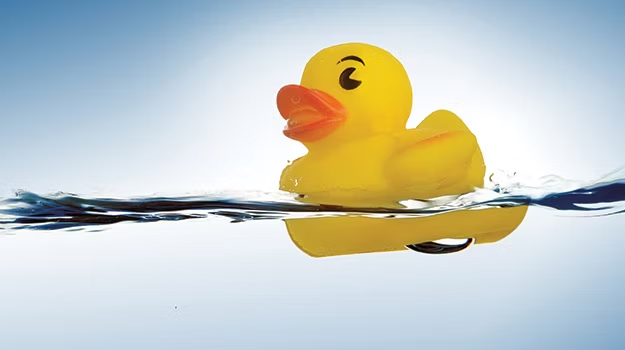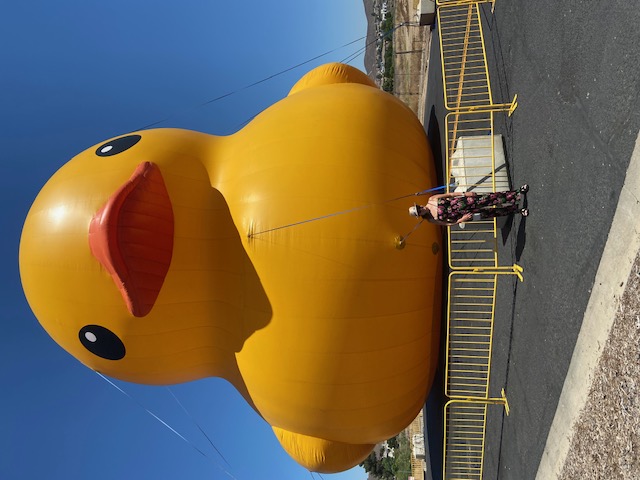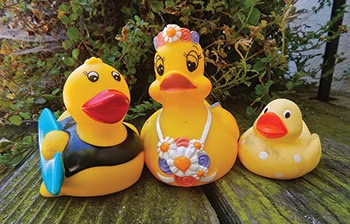Romancing the Duck


In the whimsical world of floatie toys, the rubber duck reigns supreme. For more than a century, the familiar yellow duck with an orange bill, and thousands of derivations, have been mainstays in bathtubs, spas and pools the world ‘round.
By Eric Herman
I recently had the unusual pleasure of being in the presence of the world’s largest rubber duck, named Mamma, on display this past 4th of July weekend at Storm Stadium in Lake Elsinore.
At 61 feet tall, the inflatable attraction loomed over the parking lot as part of an Independence Day fair staged by the city at the single-A minor league baseball facility. She was visible from points miles away. Described below, it turns out that Mamma has traveled the world exemplifying the iconic nature of the rubber duck.
Right up there with Barbie, G.I. Joe and alphabet blocks, the rubber duck is a genuine childhood staple, and without question the toy most associated with aquatic fun.
Today, rubber ducks take on a variety of guises and roles. The classic yellow water fowl has become fashion icon, fundraising juggernaut and even a scientific instrument.
For all of its ubiquitous popularity, however, very little is known of the rubber duck’s early history. It’s believed to have first appeared sometime in the 1880s as a solid rubber chew toy manufactured using Charles Goodyear’s newly patented process for molding rubber. In the 1930s, Disney and the Seiberling Latex Products Company made a Donald Duck rubber duck, which led the way for other commercially licensed versions.
By 1940, the familiar squeaky buoyant rubber duck was a popular item in toy stores the world over. At that time, the ducks were already made of vinyl instead of rubber, although “rubber” stays with the ducks to this day. Apparently “vinyl duck” just didn’t have the same panache.
It’s also a mystery as to when and why the color yellow was locked in as the primary color of choice. It’s believed yellow was chosen for its bright appeal and the fact that baby white ducks are covered in yellow down.
Compelling as all that may be, rubber duck history becomes far more interesting in more recent years as the familiar toy has gone on to play a surprising number of cultural roles.
Pop Star: Rubber Ducks skyrocketed into pop stardom in 1970 on “Sesame Street,” when the beloved character Ernie sang his surprisingly poignant ode, “Rubber Duckie.” The song would go on to reach number 16 on the Billboard Charts, sell over a million copies and was nominated for a Grammy in 1971.
In 1976, country music star C.W. McCall released his album titled “Rubber Duck” which included the track “Round the World with the Rubber Duck.”
Charity Fundraiser: In 1988, Arizona real estate broker Eric Schechter staged a Rubber Duck Derby, raising $180,000 for local substance abuse programs. Since then Rubber Duck racing events have been spread worldwide raising millions for hundreds of charities. The events have names like “The Ken-Ducky Derby,” “The Duck-tona 500” and the “Lucky Ducky Derby.
Accidental Adventurer: Rubber Ducks captured headlines in 1992 when a ship carrying thousands of rubber ducks toppled due to rough seas in route from Taiwan to Hong Kong. Months later, the escaped ducks, along with scores of frogs, bears and turtles began washing up on the shores of Washington and Alaska, and years later still as far away as northern Europe.
Their unlikely journey provided oceanographers with an unexpected treasure trove of data about ocean currents. The story became the subject of Donovan Hohn’s 2011 book Moby-Duck: The True Story of 28,800 Bath Toys Lost at Sea.
Royal Companion: In 2001 a Sun tabloid article claimed Queen Elizabeth II had a rubber duck with an inflatable crown in Buckingham Palace. Although the report was unconfirmed by Her Majesty, sales of rubber ducks in the U.K. skyrocketed.
Climate Research Tool: In 2008 NASA scientist Alberto Behar fitted 90 rubber ducks with GPS devices and distributed them in Greenland’s Jakobshavn Glacier, believed to be the glacier that created the iceberg that sank the Titanic. The ducks are currently being used to track ice-melt rates and ocean-current patterns in the North Atlantic. The ducks include contact information so that anyone who finds one can return it to NASA for a reward.
Objet d’ Art: In 2007, Dutch artist Florentijn Hofman created the world’s largest rubber duck, measuring 16.5-by-20-by-32 meters. In 2013 Hofman’s giant ducks were on display in waterways in Amsterdam, Lommel (Belgium), Osaka (Japan), Sydney, São Paulo (Brazil), Hong Kong, Kaohsiung (Taiwan) and Pittsburgh.
The rubber duck was finally inducted into the Toy Hall of Fame in 2013, an honor that certainly seems late in coming.
An earlier version of this article first appeared in AQUA Magazine in July 2014.











